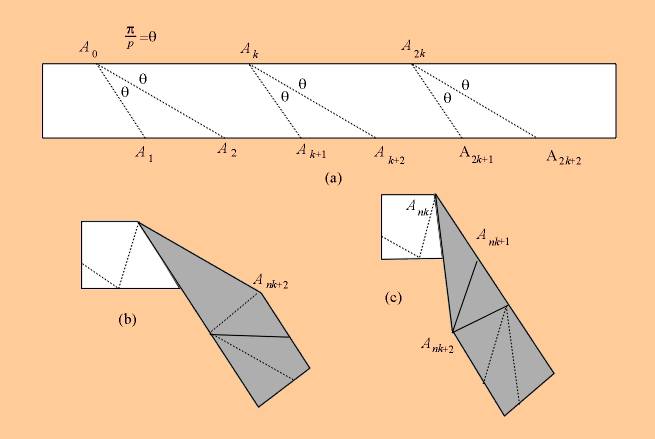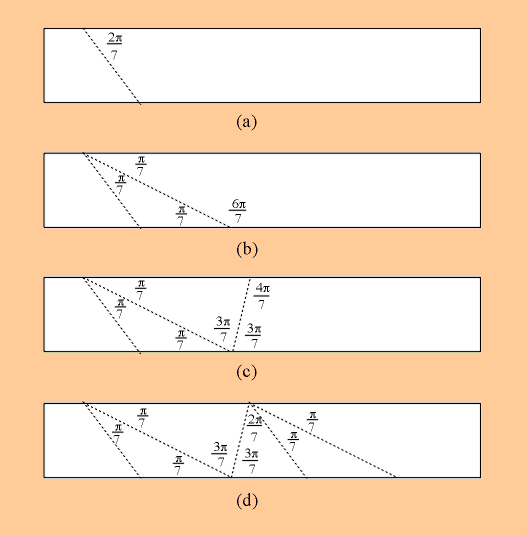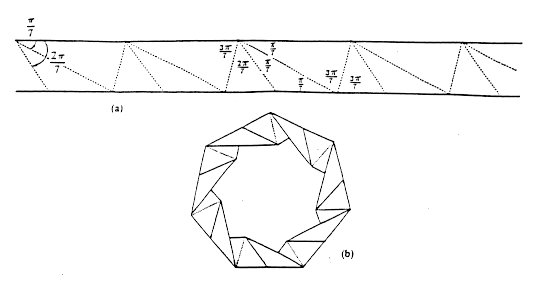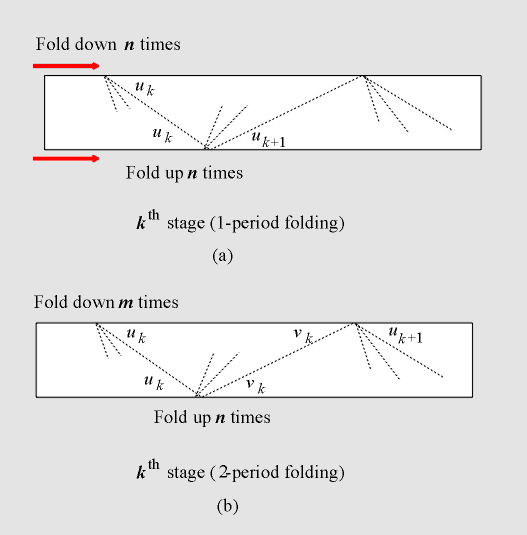
Figure 1
Now observe that if the FAT-algorithm is performed on a sequence of angles,
each of which measures p/p, at the first p of a number
of equally spaced locations along the top of the tape, in our case at
Ank for n = 0,1,2,...,p-1, then the
top edge of the tape will have turned through an angle of 2p,
so that the point Apk will then be coincident with
A0. Thus the top edge of the tape visits every vertex of a regular
convex p-gon, and thus itself describes a regular p-gon.
A picture of the tape with its crease lines, and the resulting start of
the construction of the regular p-gon, is given in Figure 2.
Notice that we have not adhered there to our systematic enumeration of the
vertices on the two edges of the tape that play
a role in the construction. (The enumeration has served its purpose!)
Notice, too, that if we had the strip of paper shown in
Figure 2(a), with
its crease lines, we could then introduce secondary crease lines bisecting
each of the angles nearest the top edge of the tape and this tape could then
be used to construct a regular 2p-gon with the FAT-algorithm. We
could then, in principle, repeat this secondary procedure, as often as we
wished, to construct regular 4p-gons, 8p-gons,...
It is for this reason that we only need to concern ourselves with devising
primary folding procedures for regular polygons having an odd number of sides
in order to be able to assure ourselves we can, indeed, fold all regular
polygons.

Figure 3
Now, since the regular convex 7-gon is the first polygon we encounter for
which we do not have available a Euclidean construction, we are faced with a
real difficulty in making available a crease line making an angle of
p/7 with the top edge of the tape.
We proceed by adopting a general policy, that we will eventually say more about
- we call it our optimistic strategy. Assume that we can crease an angle of
2p/7 (certainly we can come close) as shown in
Figure 3(a). Given that we have the angle of
2p/7, then simply folding the
top edge of the strip DOWN to bisect this angle will produce two adjacent
angles of p/7 at the top edge as shown in
Figure 3(b). (We say that
p/7 is the putative angle on this tape.) Then,
since we are content with this arrangement, we go to the bottom of the tape,
and now we really start the folding procedure.
We observe that the angle to the right of the last crease line is
6p/7 - and our policy, as paper folders, is that we always
avoid leaving even multiples of p in the numerator
of any angle next to the edge of the tape, so we bisect this angle of
6p/7, by
bringing the bottom edge of the tape UP to coincide with the last crease line
as shown in Figure 3(c). We settle for this
(because we are content with an
odd multiple of p in the numerator) and go to the top of the tape
where we observe that the angle to the right of the last crease line is
4p/7 - and, in accordance with our stated policy, we bisect
this angle twice, each time bringing the top edge of the tape DOWN to
coincide with the lase crease line, obtaining the arrangement of crease lines
shown in Figure 3(d). But now we notice something miraculous
has occurred! If we had really started with an angle of exactly
2p/7, and if we now continue introducing crease lines by
repeatedly folding the tape UP once at the bottom and DOWN twice at the top,
we get precisely what we want; namely, pairs of adjacent angles, measuring
p/7, at equally spaced intervals along the top edge of the
tape. Let us call this folding procedure the U1D2-
or D2U1-folding procedure and call
the strip of creased paper it produces 2
U1D2- or D2U1-tape.
We suggest that before reading further you get a piece of paper and fold an
acute angle that you regard as a good approximation to
2p/7. Then fold about 40 triangles using the
D2U1-folding procedure just
described, throw away the first 10 triangles, and try to construct the
FAT 7-gon shown in Figure 4(b). You will
have no doubt that what you have created is, in fact, a 7-gon, but you may
wonder why it should have worked
so well. In other words, how can we prove that this evident convergence
must take place? One approach is to admit that the first angle folded down
from the top of the tape in Figure 3(a) might
not have been precisely 2p/7. Then the bisection
forming the next crease would make two
acute angles nearest the top edge in Figure 3(b)
only approximately p/7; let us call them
p/7+e
(where e may be either positive or negative).
Consequently the angle to the right of this crease, at the bottom of the tape,
would measure 6p/7-e.
When this angle is bisected, by folding up,
the resulting acute angles nearest the bottom of the tape, labeled
3p/7 in Figure 3(c),
would, in fact, measure 3p/7-e/2,
forcing the angle to the right of this
crease line at the top of the tape to have measure
4p/7+e/2.
When this last angle is bisected twice
by folding the tape down, the two acute angles nearest the top edge of the
tape will measure p/7+p/23.
This makes it clear that every time we repeat a
D2U1-folding on the tape the error is
reduced by a factor of 23.

Figure 4
Now it should be clear how our optimistic strategy has paid off. By blandly
assuming we have an angle of p/7 to begin with, and folding
accordingly, we get what we want - successive angles at the top of the tape
which, as we fold, rapidly get closer and closer to
p/7! A truly remarkable vindication of our optimistic strategy!
In practice the approximations we obtain by folding paper are quite as
accurate as the real world constructions with a straight edge and compass -
for the latter are only perfect in the mind. In both cases the real world
result is a function of human skill, but our procedure, unlike the Euclidean
procedure, is very forgiving in that it tends to reduce the effects of human
error - and, for many people, it is far easier to bisect an angle by
folding paper than it is with a straight edge and compass.
Observe that it is in the nature of the folding procedure that we will always
be folding DOWN a certain number of times at the top and then folding UP a
certain (not necessarily the same) number of times at the bottom and then
folding DOWN (possibly an entirely new) number of times at the top, etc.
Indeed, a typical folding procedure may be represented by a sequence of
exponents attached to the letters DUDUDUDU... the sequence
stopping to avoid simply repeating a given finite string of exponents. The
length of the repeat for the exponents is called the period of the folding
procedure. (Thus the folding that produced the 7-gon is called a
2-period folding procedure.) It is an important fact that,
for every odd p, a regular p-gon may be folded by instructions so
encoded. It is thus very natural to ask what regular p-gons can be
produced by the 2-period folding procedure?
In the process of answering this question we make straightforward use of the
following:3
Lemma 2.1 For any three real numbers
a, b and x0,
with a ¹ 0, let the sequence
{xk}, k = 0,1,2,... be defined by the
recurrence relation
|
xk + axk+1 = b,
k = 0,1,2,...
(2.1) |
|
Then if |a| > 1, xk
® b/(1+a) as k
® ¥.
Proof: Set xk = b/(1+a) + yk.
Then yk + ayk+1 = 0.
It follows that yk = ((-1)/a)ky0.
If |a| > 1, ((-1)/a)k
® 0,
so that yk ® 0
as k ® ¥.
Hence xk ® b/(1+a) as
k ® ¥. Notice that
yk is the error at the kth stage, and that
the absolute value of yk is equal to
|y0|/|a|k.
This result is the special linear case of the Contraction Mapping Principle
(see [W]). We point out that it is significant that neither
the convergence nor the limit depends on the initial value
x0. This implies, in terms of the folding,
that the process will converge, and to the
same limit, no matter how we fold the tape to produce the first line - this
is what justifies our optimistic strategy! And, as we have seen in our
example, and as we will soon demonstrate in general, the result of the lemma
tells us that the convergence of our folding procedure is rapid, since in all
cases |a| will be a positive power of 2.

Figure 5
Now we will look at the general 2-period folding procedure,
DmUn. In this case a typical portion of the
tape would appear as shown in Figure 5(b).
If the folding process had been started with an arbitrary angle
u0 at the top of the tape we would have, at the kth
stage,
and hence it follows that
|
uk - 2m+nuk+1
= p(1-2n), k = 0,1,2,... |
|
Thus, using Lemma 2.1, we see that
as k ® ¥,
so that (2n-1)p/(2m+n-1)
is the putative angle ap/b.
Thus the FAT-algorithm will produce, from this tape, a
star {b/a}-gon, where the fraction b/a may turn
out not to be reduced (for example when
m = 4, n = 2), with a = 2n-1, b =
2m+n-1. By symmetry we infer that
as k ® ¥.
Furthermore, if we assume an initial error E0 then we know that the
error at the kth stage (when folding DmUn
has been done exactly k times) will be given by Ek =
E0/2(m+n)k.
Hence, we see that in the case of our D2U1-folding
(Figure 3) any initial error E0
is, as we already saw from our initial argument,
reduced by a factor of 23 between consecutive states. It should now
be clear why we advised throwing away the first part of the tape - but,
likewise, it should also be clear that it is never necessary to throw away
very much of the tape. In practice, convergence is very rapid indeed, and
if one made it a rule of thumb always to throw away the first 20 crease
lines on the tape for any iterative folding procedure, one would be
absolutely safe.
We have seen that the DmUn-folding procedure,
or, as we may more succinctly describe it, the (m,n)-folding procedure,
produces angles p/s on the tape, where
Notice that when n = m the folding becomes, technically,
a 1-period folding procedure which produces a regular s-gon,
where s = (22n-1)/(2n-1) =
2n+1. Thus we see, immediately, that the
DnUn-folding will produce tape to which
the FAT-algorithm can be applied
to obtain regular (2n+1)-gons. These constructions provide
approximations to many (but not all) of the polygons the Greeks and Gauss
were able to construct with Euclidean tools. We can certainly construct a
regular polygon whose number of sides is a Fermat number, but
(see [Rec]) it is never possible to construct,
with a 1-period folding those regular polygons where the number of sides
is the product of at least
two distinct Fermat numbers (thus, 15 serves as the first example where we
find trouble).
The polygons which are of most interest to us in the construction of regular
polyhedra are those with 3 or 5 sides (since we have exact
constructions for the square). Our companion article [Rec] of
this issue contains very explicit instructions of the folding procedures that
produce the D1U1- and the
D2U2-tape (which can be used to
construct 3- and 5- gons, respectively) along with equally explicit
instructions for building some braided polyhedra from the tape produced.
The reader is encouraged to at least peruse that part of this issue before
going on, since we will be making references to some of the models whose
construction is described there in the next section.
Before we begin the discussion of symmetry let us finish explaining how you
might construct those regular polygons that cannot be folded by
the 1- or 2-period folding procedures. For example, suppose we wanted to
construct a regular 11-gon. Our arguments in
[HP1, 2
or 3] show that no 2-period
(or 1-period) folding procedure can
possibly produce an 11-gon.
In fact, the example of constructing the regular 11-gon is sufficiently
general to show the construction of any regular p-gon, with p odd.
So let us demonstrate how to construct a regular 11-gon. we proceed as
we did in the construction of the regular 7-gon (in Section 2) - we
adopt our optimistic strategy (which means that we assume we've got what we
want and, as we will show, we then actually get what we want!). Thus we
assume we can fold an angle of 2p/11. We bisect it by
introducing a crease line, and follow the crease line to the bottom of the
tape. The folding procedure now commences at the bottom of the tape. Thus
(1) Each new crease line goes in the forward (left to right) direction along the tape;
(2) Each new crease line always bisects the angle between the last crease
line and the edge of the tape from which it emanates;
(3) The isection of angles at any vertex continues until a crease line produces an
angle of the form ap/11
where a is an odd number; then the folding stops at that
vertex and commences at the intersection point of the last crease line with
the other edge of the tape.
Once again the optimistic strategy works and our procedure results in tape
whose angles converge to those shown in Figure 6(b).
We could then denote this folding procedure by
U1D1U3D1
U1D3...
interpreted in the obvious way on the tape - that is, the first exponent
"1" refers to the one bisection (producing a line in the upward
direction) at the vertices A6n (for n = 0,1,2,...)
on the bottom of the tape; similarly
the next "1" refers to the bisection (producing a crease in the
downward direction) made at the bottom of the tape through the vertices
A6n+1; etc. However, since the folding procedure is duplicated
halfway through, we can abbreviate the notation and write simply {1,1,3},
with the understanding that we alternately fold from the
bottom and top of the tape as described, with the number of bisections at
each vertex running, in order, through the values 1, 1, 3,... We
call this a primary folding procedure of period 3 or a 3-period folding,
for obvious reasons. The crease lines made during this procedure are called primary
crease lines.